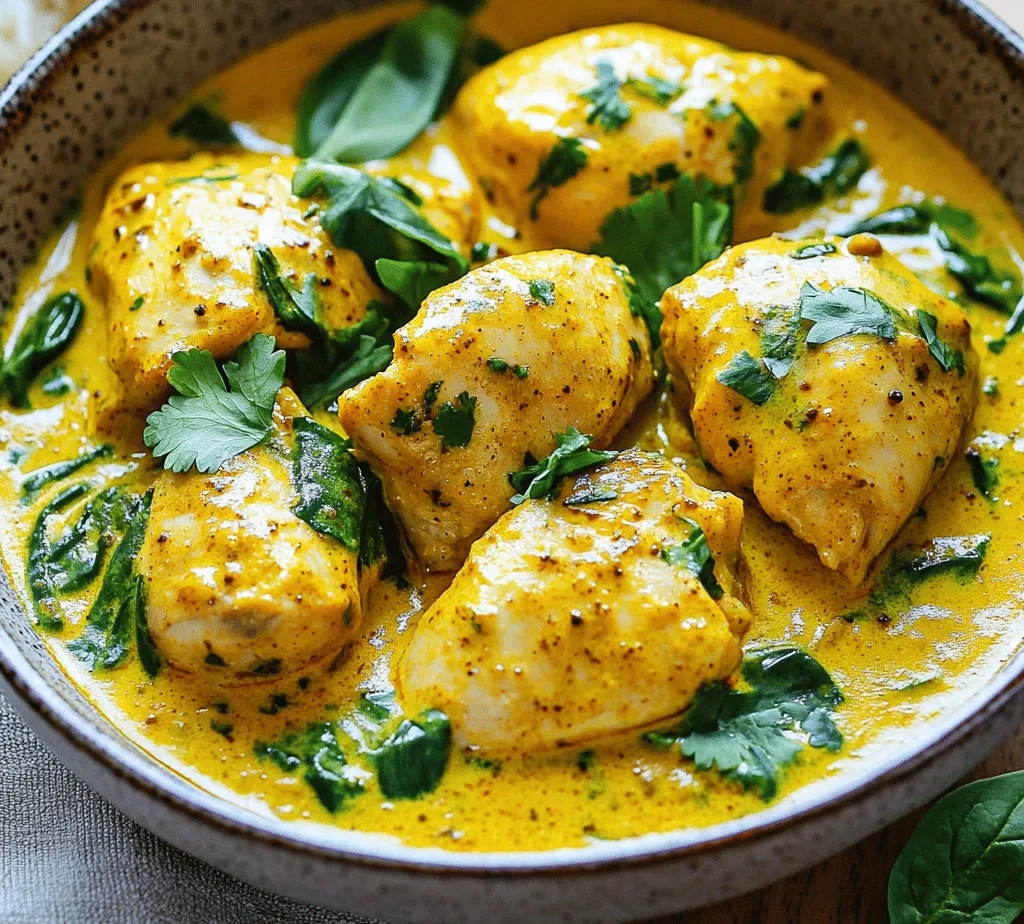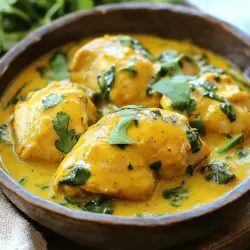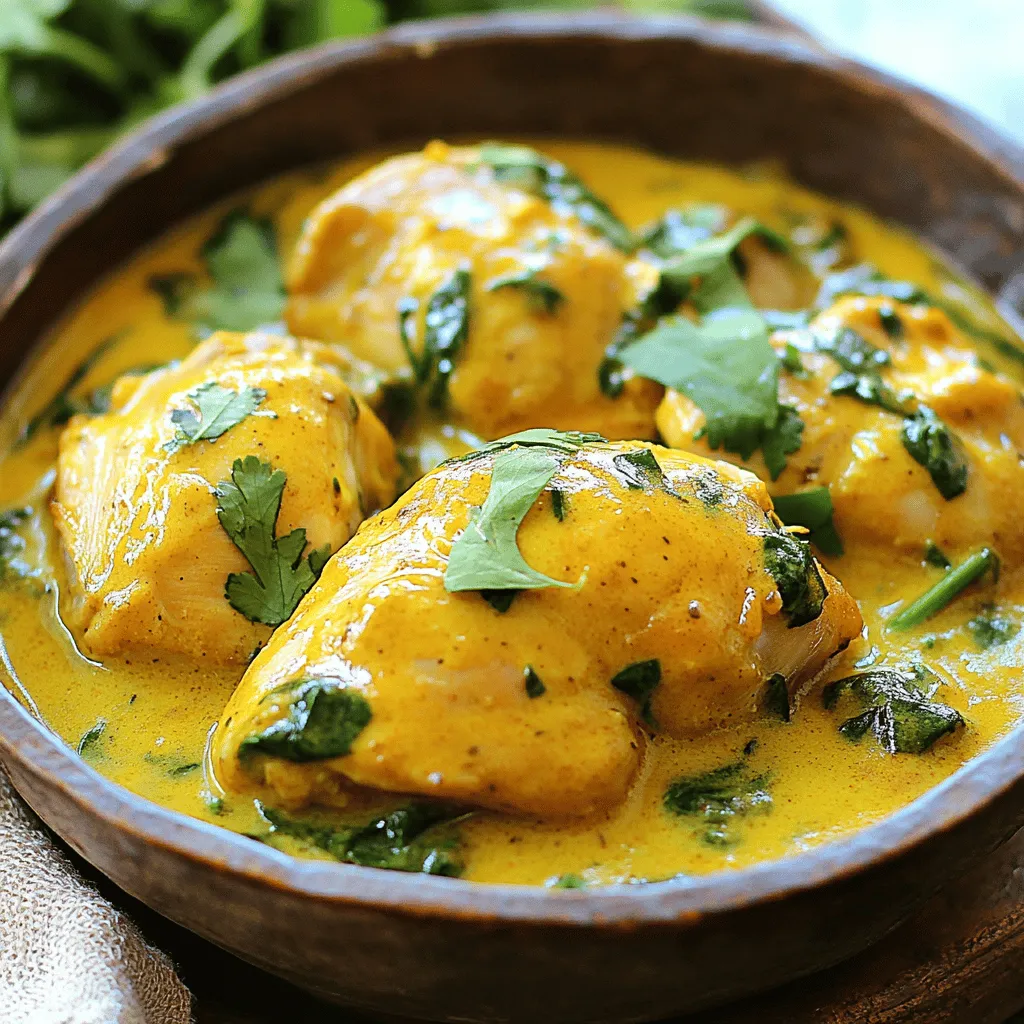Introduction
Indian cuisine has captivated the palate of food lovers worldwide, thanks to its rich tapestry of flavors, colors, and aromas. The global popularity of Indian dishes can be attributed to their diverse ingredients and the harmonious blend of spices that characterize this culinary tradition. Among the many gems of Indian cooking, the Tropical Bliss Indian Coconut Chicken Curry stands out as a delightful fusion dish that marries the essence of traditional Indian flavors with the light, refreshing notes of tropical ingredients.
This coconut chicken curry is not just a feast for the senses; it is also a dish that celebrates health and wellness. The inclusion of coconut milk provides a creamy texture that enhances the curry while offering numerous health benefits, such as boosting heart health and aiding digestion. Coupled with succulent chicken thighs and a vibrant array of spices, this dish is a perfect introduction to the heart of Indian cooking, encapsulating the warmth of its heritage and the freshness of tropical ingredients.
As we embark on this culinary adventure, you’ll learn not just how to prepare this delightful dish but also the significance of each ingredient and the techniques that elevate it to new heights of flavor.
Understanding the Ingredients
To create a memorable Tropical Bliss Indian Coconut Chicken Curry, it’s essential to understand the role of each ingredient. Here is a detailed breakdown of the components that contribute to the dish’s unique flavor profile.
Chicken Thighs
When it comes to chicken for curry, thighs are often the preferred cut over breasts. The reason lies in their higher fat content, which ensures that they remain moist and flavorful throughout the cooking process. Chicken thighs can withstand longer cooking times without drying out, making them ideal for slow-simmered dishes like this coconut curry. Their tender texture absorbs flavors beautifully, resulting in a rich and satisfying bite.
Coconut Milk
Coconut milk is a key ingredient in this recipe, lending a luxurious creaminess that forms the foundation of the curry’s sauce. Beyond its delightful texture, coconut milk is packed with health benefits, including healthy fats that can improve cholesterol levels and promote heart health. It also adds a subtle sweetness that balances the spices, creating a harmonious flavor profile.
Aromatic Trio: Onions, Garlic, and Ginger
In Indian cooking, the aromatic trio of onions, garlic, and ginger is indispensable. Onions provide a sweet and savory base when sautéed, forming the foundation of the curry. Garlic adds a pungent depth, while ginger introduces a refreshing, zesty note that brightens the dish. Together, they create a fragrant base that enhances the overall flavor of the curry.
Spices
The spices used in this recipe are what truly set Indian cuisine apart. The significance of each spice cannot be overstated:
– Curry Powder: A blend of spices that varies by region, curry powder is essential for imparting warmth and complexity to the dish.
– Coriander: Adds a fresh, citrusy flavor that complements the richness of the coconut milk.
– Cumin: Offers an earthy, nutty aroma that enhances the overall depth of the curry.
– Turmeric: Known for its vibrant yellow color, turmeric provides a warm, slightly bitter flavor and is celebrated for its anti-inflammatory properties.
– Chili Powder: This spice adds heat to the curry, allowing you to adjust the spice level according to your preference.
Tomatoes
Tomatoes play a crucial role in enhancing the flavor and texture of the curry. They add acidity, which balances the richness of the coconut milk, and their natural sweetness helps to round out the dish. Fresh or canned tomatoes can be used, depending on availability and personal preference.
Optional Ingredients
To elevate the dish further, consider incorporating optional ingredients such as:
– Spinach: Adding fresh spinach not only boosts the nutritional value of the curry but also introduces a vibrant green color, making the dish visually appealing.
– Lime: A squeeze of fresh lime juice at the end of cooking adds brightness and a refreshing tang, balancing the richness of the coconut milk.
Preparation Steps Explained
Now that we have a comprehensive understanding of the ingredients, it’s time to dive into the preparation steps that will guide you through creating the perfect Tropical Bliss Indian Coconut Chicken Curry.
Step 1: Sautéing the Onions
Start by heating a generous amount of oil in a large pot over medium heat. Once hot, add finely chopped onions and sauté them until they turn golden brown. This step is crucial, as caramelizing the onions develops a deep, rich flavor that forms the backbone of the curry. Patience is key here; allow the onions to cook thoroughly to release their natural sweetness.
Step 2: Adding Garlic and Ginger
Once the onions are beautifully caramelized, add minced garlic and grated ginger. Sauté for an additional 1-2 minutes until the mixture is fragrant. This aromatic base is the heart of the dish, setting the stage for the spices to shine.
Step 3: Cooking the Spice Blend
Next, it’s time to add the spices. Sprinkle in the curry powder, coriander, cumin, turmeric, and chili powder. Toasting the spices in the oil for a minute or two allows the essential oils to release, enhancing their flavors. Stir continuously to ensure that the spices do not burn, which could impart a bitter taste to the curry.
Step 4: Searing the Chicken
Now it’s time to introduce the chicken thighs. Cut them into bite-sized pieces and add them to the pot, stirring to coat them with the spice mixture. Searing the chicken helps to lock in moisture while creating a delightful crust. Cook the chicken for about 5-7 minutes, allowing them to brown slightly on the edges.
Step 5: Adding Tomatoes and Coconut Milk
After the chicken is seared, add diced tomatoes to the pot. Stir well, allowing the tomatoes to soften and release their juices, which will help deglaze the pot. Next, pour in the coconut milk, stirring to combine everything into a smooth and creamy sauce. At this point, you can also add any additional ingredients, such as spinach, to boost nutrition.
Step 6: Simmering the Curry
Once combined, bring the curry to a gentle simmer. Cover the pot and let it cook for about 20-30 minutes. This step is crucial, as simmering allows the flavors to meld together while ensuring the chicken becomes tender and juicy. The steam trapped in the pot will help cook the chicken thoroughly, so it’s essential to keep the lid on during this stage.
Step 7: Adding Lime Juice and Adjusting Seasoning
After simmering, taste the curry and adjust the seasoning as needed. A squeeze of fresh lime juice at the end adds brightness and freshness, balancing the richness of the coconut milk. If desired, garnish with fresh cilantro for an additional layer of flavor.
Balancing Flavors in Indian Cooking
The beauty of Indian cooking lies in its emphasis on balancing flavors. When preparing this Tropical Bliss Indian Coconut Chicken Curry, remember that each ingredient contributes to the overall taste. Experiment with spice levels, sweetness, and acidity to find the balance that suits your palate. Whether you prefer a milder curry or one with an extra kick, the key is to taste and adjust as you go along.
As we continue exploring this delightful recipe, you’ll discover how to perfect it with additional tips and tricks, ensuring that every bite is a burst of tropical bliss. Stay tuned for the next part of our journey into creating this aromatic and satisfying dish.




